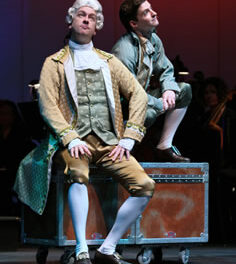It is odd how some works dominate the concert repertoire to the neglect of later, more mature works by the same composer. That is true for the first piano trios by Schubert and Brahms, Op.99 and Op. 8 respectively. The Piano Trio No. 2 in C minor, Op. 66 by Felix Mendelssohn (1809-1847) is even more neglected in favor of the composer’s youthful First Piano Trio. In the Eastern Music Festival‘s fine program notes, author William R. Trotter speculates the young Mendelssohn’s eagerness to apply all the music theory he had just learned played a role. Egon Kenton, in the CD program note to the Kalichstein-Laredo-Robinson Piano Trio’s first recording of the composer’s trios, writes “the first of the pair is more spontaneous” than the “more weighty & worked out second” trio. The EMF’s faculty’s committed performance of the Second Trio in the intimate Carnegie Room of the Hege Library on the picturesque Guilford College campus was most welcome.
The performers in the Op. 66 trio were pianist Marian Hahn, violinist Penny Thompson Kruse, and cellist Rebecca Zimmerman. The string players were familiar as players in the all professional Eastern Festival Orchestra heard on Saturday nights. Hahn spoke briefly before the performance, saying while this was her first EMF season she was no stranger to the Triad, having been on the faculty of the University of North Carolina School of the Arts. While the first trio is more popular with the public, she said most musicians preferred the second. She drew attention to the magical entrance of the chorale in the finale by playing its theme. Balance between the strings and piano were generally good. During the agitated first movement, there were fleeting moments when reverberation from the hall’s hard surfaces threatened to cause the piano to swamp the strings, but Hahn held the course and the three other movements were finely balanced. The fine, warm tone of the string players was on display in the slow movement. The quicksilver scherzo revealed excellent articulation of all three players despite the rapid pace. Kruse’s spot-on intonation was welcome in the exposed high notes throughout, while Zimmerman’s full, rich cello sound was a constant pleasure. The chorale in the middle last movement, “Vor Deinen Thron” (Before Thy Throne), received its full effect. Used by J.S. Bach in his last composition, “Leipzig Chorale Prelude” S.668, this was an apt allusion to Mendelssohn’s long dedication to the master and the revival of his works.
Five more faculty musicians joined to present a real rarity, the First Piano Quintet in C minor by Ernest Bloch (1880-1959), a work totally unfamiliar to me. Trotter’s program note points out Bloch’s cycle of string quartets have been compared favorably to those by Bartók, and he alludes to the “Old Testament prophet-like” quality of Bloch’s declamatory style. The composer brilliantly uses quartertone intervals “to invest the music with colors that evoke an eerie, unsettling out-of-this world quality.” This brusque restless and propulsive music was a challenge to take in on first hearing but it left me wanting to hear it again. There are odd juxtapositions between strings and piano throughout the quintet’s three movements. The first and last movements are agitated while the middle slow movement is dominated by eerie high string harmonics. Strings are heard throughout at unexpected extremes of their registers. Melodies taken up by one instrument are passed on to the other players, often set against repeated trills or ostinato figures in the piano or strings. Despite the gargantuan nature of the score, balance between the piano and strings was fine. The players were pianist James Giles, violinists Randall Weiss and Diana Tsaliovich, violist Daniel Reinker, and cellist Marta Simidtchieva. Reinker’s gorgeous viola tone was welcome during significant leading solo or leading melodies in the second and third movements. This performance whetted the appetite to further explore this and other chamber works by Bloch.











